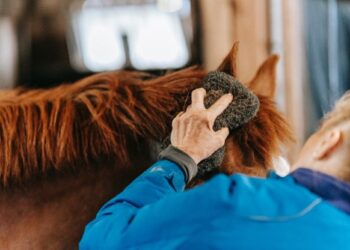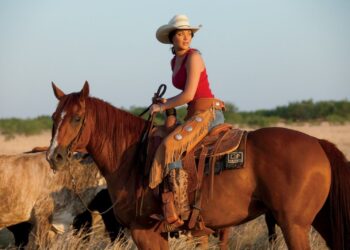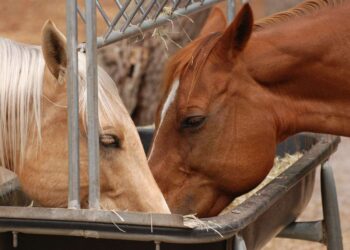Without the use of expensive equipment, we really only notice from the outside if our horse is wrong. This will become apparent from his behavior and body language, but we can also get information from the condition of his coat, hooves, ears, eyes, nose, and mouth. However, in order to judge whether a horse has one, we must first know how a healthy horse should look and behave. Only then can we notice deviations.
The condition of the horse
The overall condition of a horse mainly relates to its weight and fitness (energy). The two are closely related.
Reading suggestions; 500 Horse Names For Male and Female Horse Names
Weight
A decrease in fitness is not infrequently accompanied by an unusual increase or decrease in weight. With an increase in weight, overfeeding (of fat or sugar-rich food), whether or not in combination with too little exercise, is the cause
. In addition to too little food or a training schedule that is too heavy, a worm infection or other condition can also be the cause of a decrease in weight. How do you know if a horse is overweight or underweight? You can make a simple, rough estimate by running your hand over the horse’s flank. You should not be able to see the horse’s ribs, but you can feel them.
You will not be able to feel or see the ribs on an overweight horse. A severely overweight horse has lobes of fat on its shoulders, neck, and hindquarters (the clearly visible groove over the loin). In an underweight horse, you can clearly feel and see the ribs and the hip bones and loins will also clearly protrude on the hindquarters. In addition, the neck will often be sunken and the coat will look dull and unkempt.
Measuring is knowing
If you want more certainty, you can track the weight with special scales, but these are not available in many stables. There are also special measuring tapes that ‘measure’ weight using a conversion formula. In addition,
it is also possible to calculate the weight of a horse using a formula. Below is this formula (NB this formula cannot be used for small ponies):
((Chest size in cm x 4.3) + (Height at the withers in cm x 3)) – 785 kg = weight in kg. Still, it’s always better to be sure so if you get the chance to use a horse scale, do it to get an accurate reading.
fitness
Your horse’s fitness is something you can track by tracking heart rate and breathing before, during, and after training. If you notice noticeable changes in your horse’s fitness, for example, that his resting heart rate and breathing are too fast, or that it takes much longer to return to their normal values after training, then this is a reason for further investigation.
Reading suggestions; Top 7 Best Horse Brushes to Keep Your Horses Clean
the fur
The condition of the horse’s coat is a very important indicator of its health. A healthy coat should have a nice shine and lie flat against the skin. It should also feel soft and supple. The skin under the coat should be a very light color and also elastic, so it should spring back into place when lifted up.
Deviations How
can you see that there is a health problem in the coat? Clearly recognizable problems are bald spots and wounds. Fungal infections and annoying allergic reactions to insect bites, for example, are also common. In addition, the coat itself can also become dull when the general condition of a horse deteriorates, the hair no longer closes properly and the coat feels rough.
In some conditions, the coat becomes very thick and curly. As with all other concerns, it is very important for the coat to know the normal condition of your horse’s coat and to check it regularly so that changes are noticed very quickly. Daily brushing is an excellent time for this.
Eyes, ears, nose, and mouth
The horse’s ears, eyes, nose, and mouth must be clean and free of parasites or pus and snot. The ears of an alert horse should be erect and free to rotate in all directions. Be careful not to get ear parasites in the ears. If a horse shakes its ears frequently or suddenly tries to avoid touching the ears, it could indicate a problem.
A horse’s eyes should shine brightly and have a ‘soft’ look, meaning the horse should look ‘friendly’. Abundant discharge, swelling and pale or red mucous membranes around the eyes indicated problems. The nostrils should be clean and light pink on the inside. Outgrowth should be clear and watery. Thick, yellowish, or greenish discharge indicates inflammation.
The most important part of the mouth is the teeth and molars. These should all be rounded in shape (appropriate to the age of the horse) and should not contain hooks or other sharp edges or protrusions. The horse’s gums should fit snugly to the teeth and should not show any bleeding or inflammation (red, swollen spots).
An indication that something is wrong with the teeth may be that the horse reacts differently to the bit or does not chew its food properly (it falls out of its mouth). Regular checkups by a dentist help prevent problems.
the hooves
The horse’s hooves can actually be compared to a human nail. The ancestors of today’s horses had four toes, one by one that has been replaced by one large hoof. The largest part of the horse’s leg is anatomically part of the foot.
The healthy hoof is nicely rounded in shape (the front hooves are usually slightly rounded in shape than the rear hooves) and the hoof wall shows no crumbs and/or cracks. The sole on the underside of the hoof is flat, free of ulcers, foreign objects, and/or damage and is not sunken (hollow hoof) or protrudes below the hoof wall.
The jet grooves are not too deep so that no dirt can accumulate in them. In addition to this superficial assessment, it is also important to see if a horse is not lame or if the hoof is loaded unevenly because this can also mean that the hoof is not healthy. In any case, have your horse checked and cared for regularly by a qualified farrier.
Reading Suggestion: 6 Best Horse Clippers For Body Clipping
Behavior and health
Just like humans, horses are not well off when they are in pain or ill. An important distinction, however, is that horses sometimes show this very late, or even not at all. Horses are prey animals and predators always choose the weakest members of the herd. So a horse is evolutionarily programmed not to show weakness. In some horses,
this instinct is so strong that even very serious conditions go unnoticed until the pain becomes really unbearable for the horse. How can you tell that your horse is in pain?
This is only possible if you know your horse very well. Tiny changes in his movement, facial expression, and behavior can be expressions of pain or discomfort. Especially with sudden and extreme changes in behavior, alarm bells should start ringing.
A calm horse that suddenly becomes restless, a hot horse that suddenly becomes lethargic, in short: everything that stands out as new and suddenly emerging behavior almost certainly points (otherwise the same circumstances) to a health problem.
Intuition
The above tips are clearly recognizable indications that something is wrong with your horse, but sometimes you feel that there is something different about your horse, but you can’t put your finger on what it is. Remember that you know your horse best.
If your gut feeling says something isn’t right, but you can’t figure out what’s causing it, trust your intuition and find a vet or specialist who will take your concerns seriously and work with them to find out what’s wrong with your horse. Hopefully, you can save your horse and yourself a lot of trouble this way.







